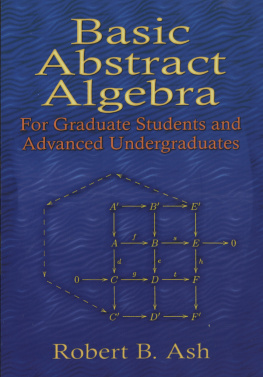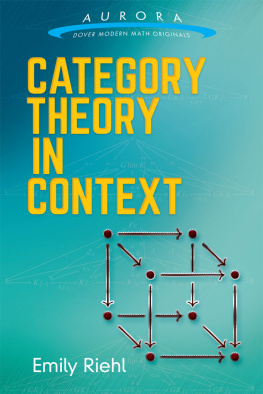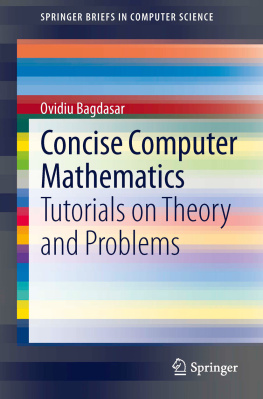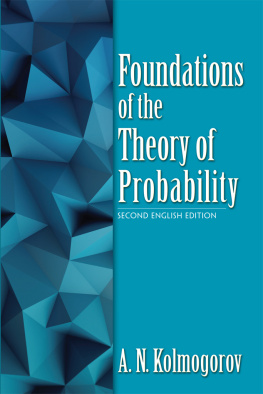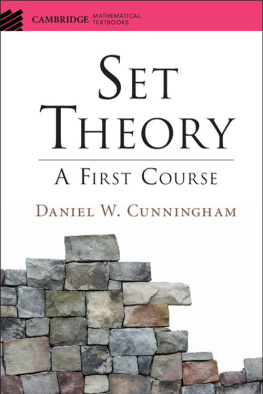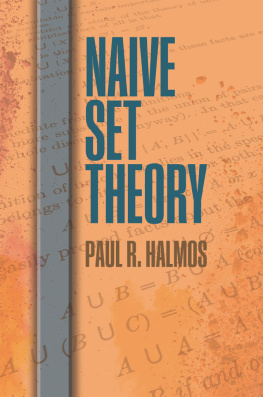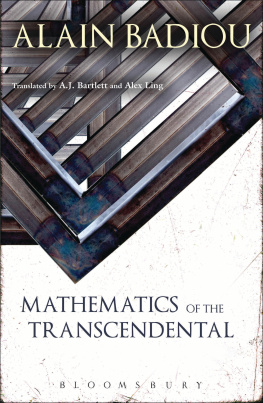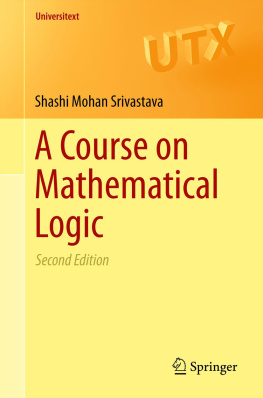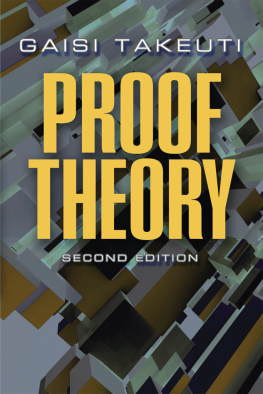TOPOS
THEORY
TOPOS
THEORY
P. T. JOHNSTONE
Dept. of Pure Mathematics and
Mathematical Statistics
University of Cambridge
Cambridge, England
DOVER PUBLICATIONS, INC.
Mineola, New York
Copyright
Copyright 1977 by P. T. Johnstone
All rights reserved.
Bibliographical Note
This Dover edition, first published by Dover Publications, Inc., in 2014, is an unabridged republication of the work originally published by Academic Press, Inc., New York, in 1977.
International Standard Book Number
eISBN-13: 978-0-486-78309-3
Manufactured in the United States by Courier Corporation
49336901 2014
www.doverpublications.com
Preface
The origins of this book can be traced back to a series of six seminars, which I gave in Cambridge in the winter of 1973/74, and which formed the nucleus of the present ; the remainder of the text was completed during May-July 1976 after my return to Cambridge.
The lectures and seminars mentioned above had a very direct influence on the text of the book, and all those who attended them (in particular those whose names appear above) deserve my thanks for the part they have played in shaping it. But I have also benefited from more informal contacts with many mathematicians at conferences and elsewhere. Among those whose (largely unpublished) ideas I have gladly borrowed are Julian Cole, Radu Diaconescu, Mike Fourman, Peter Freyd, Andr Joyal and Chris Mulvey. John Gray gave me valuable advice on 2-categorical matters, and Jack Duskin and Barry Tennison helped to improve my understanding of cohomology. And I must thank Jean Bnabou for the many ideas I have consciously or inadvertently borrowed from him, and Tim Brook for his help in the compilation of the bibliography.
There remain four mathematicians to whom I owe a debt which must be acknowledged individually. Myles Tierney introduced me to topos theory through his lectures at Varenna in 1971; looking back on the published version ] served as a model for some parts of this book. Like every other worker in topos theory, I owe Bill Lawvere an overwhelming debt in general terms, for his pioneering insights; but I have also benefited at a more personal level from his ideas and conversation. Above all, I have to express my indebtedness to Saunders Mac Lane: but for him I should never have become a topos-theorist in the first place; and the care with which he has read through the original typescript, and provided suggestions for improvement in almost every paragraph, has been altogether out of the ordinary. If there are any major errors or obscurities still remaining in the text, they are surely a testimony to my perversity rather than his lack of vigilance.
On a different, but no less significant, level, I must also thank the Universities of Liverpool and Chicago, and St Johns College, Cambridge, for employing me during the writing of the book; Paul Cohn, for accepting it for publication in the L.M.S. Monographs series; and the staff of Academic Press for the efficiency with which they have transformed my amateurish typescript into the book which you see before you.
Cambridge, June 1977 | P.T.J. |
Introduction
Topos theory has its origins in two separate lines of mathematical development, which remained distinct for nearly ten years. In order to have a balanced appreciation of the significance of the subject, I believe it is necessary to consider the history of these two lines, and to understand why they came together when they did. I therefore begin this Introduction with a (personal, and doubtless strongly biased) historical survey.
The earlier of the two lines begins with the rise of sheaf theory, originated in 1945 by J. Leray, developed by H. Cartan and A. Weil among others, and culminating in the published work of J. P. Serre ].)
However, in algebraic geometry it was soon discovered that the topological notion of sheaf was not entirely adequate, in that the only topology available on an abstract algebraic variety or scheme, the Zariski topology, did not have enough open sets to provide a good geometric notion of localization. In his work on descent techniques ], A. Grothendieck observed that to replace Zariski-open inclusion by tale morphism was a step in the right direction; but unfortunately the schemes which are tale over a given scheme do not in general form a partially ordered set. It was thus necessary to invent the notion of Grothendieck topology on an arbitrary category, and the generalized notion of sheaf for such a topology, in order to provide a framework for the development of tale cohomology.
], including some notable additional results of P. Deligne, eight years later.) Among the most important results of the original seminar was the theorem of Giraud, which showed that the categories of generalized sheaves which arise in this way can be completely characterized by exactness properties and size conditions; in the light of this result, it quickly became apparent that these categories of sheaves were a more important subject of study than the sites (= categories + topologies) which gave rise to them. In view of this, and because a category with a topology was seen as a generalized topological space, the (slightly unfortunate) name of topos was given to any category satisfying Girauds axioms.
Nevertheless, toposes were still regarded primarily as vehicles for carrying cohomology theoreies; not only tale cohomology, but also the fppf and crystalline cohomologies, and others. The power of the machinery developed by Grothendieck was amply demonstrated by the substantial geometrical results obtained by using these cohomology theories in the succeeding years, culminating in P. Delignes proof ]. It was, therefore, necessary that a second line of development should provide the impetus for the elementary theory of toposes.
The starting-point of this second line is generally taken to be F. W. Lawveres pioneering 1964 paper on the elementary theory of the category of sets ]. It was this theorem which, by showing that there is an explicit set of elementary axioms which imply all the (finitary) exactness properties of module categories, paved the way for a truly autonomous development of category theory as a foundation for mathematics.
(Incidentally, the Freyd-Mitchell embedding theorem is frequently regarded as a culmination rather than a starting-point; this is because of what ].)
This theorem was soon followed by Lawveres paper [] did the same for the category of topological spaces.)
One may well ask why this paper was not immediately followed by the explosion of activity which greeted the introduction of elementary toposes six years later. In retrospect, the answer is that Lawveres axioms were too specialized: the category of sets is an extremely useful object to have as a foundation for mathematics, but as a subject of axiomatic study it is not (pace the activities of Martin, Solovay et al.!) tremendously interestingit is too rigid to have any internal structure. In a similar way, if the abelian-category axioms had applied only to the category of abelian groups, and not to categories of modules or of abelian sheaves, they too would have been neglected. So what was needed for the category of sets was an axiomatization which would also cover set-valued functor categories and categories of set-valued sheavesi.e. the axioms of an elementary topos.
In his subsequent papers (]) on logical and semantical categories.
Meanwhile, the embedding-theorem side of things was advanced by M. Barr ], who used it in their investigations of general sheaf theory; and Barr himself observed that Girauds theorem could be regarded as little more than a special case of his embedding theorem. This perhaps represents (logically, if not chronologically) the first coming-together of the two lines of development mentioned earlier.
Next page

